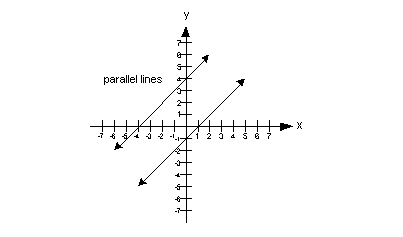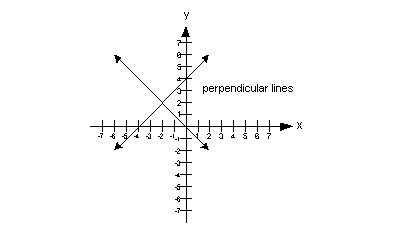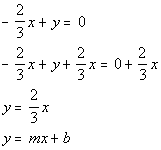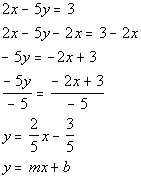

![]() Learning Objectives
Learning Objectives
![]() Introduction
Introduction
![]() Tutorial
Tutorial
Note that two lines are parallel if their slopes are equal and they have different y-intercepts.


![]()
This form can be handy if you need to find the slope of a line given the equation.
 Example
1: Find the slope of any line that is a)
parallel
and b) perpendicular to the line
Example
1: Find the slope of any line that is a)
parallel
and b) perpendicular to the line Recall that when you are given the equation of a line
that you can find
the slope of it by writing it in the slope/intercept
form, ![]() ,
where m is the slope and b is
the y-intercept of the line.
,
where m is the slope and b is
the y-intercept of the line.
This equation is already written in the slope/intercept form:
If you said -7, you are correct!!!
Slope of the parallel line:
Since parallel lines have the same slope what do you think the slope
of any parallel line to this line is going to be? Pat yourself on the
back if you
said
-7.
Slope of the perpendicular line:
Since the slopes of perpendicular lines are negative reciprocals of
each other, what do you think the slope of any perpendicular line
to this line is?
Give yourself a high five if you said 1/7.
Remember that you take the reciprocal which is -1/7 and
then you negate
it to get the 1/7 for your perpendicular slope.
The slope of any parallel line to the line ![]() is -7 and the slope of any perpendicular
line to the line
is -7 and the slope of any perpendicular
line to the line ![]() is 1/7.
is 1/7.
 Example
2: Find the slope of the line that is a)
parallel
and b) perpendicular to the line
Example
2: Find the slope of the line that is a)
parallel
and b) perpendicular to the line Recall that when you are given the equation of a line
that you can find
the slope of it by writing it in the slope/intercept
form, ![]() ,
where m is the slope and b is
the y-intercept of the line.
,
where m is the slope and b is
the y-intercept of the line.
Rewriting this equation in the slope/intercept form we get:

*Written in slope/intercept form
If you said 2/3, you are correct!!!
Slope of the parallel line:
Since parallel lines have the same slope what do you think the slope
of the parallel line is going to be? Pat yourself on the back if you
said
2/3.
Slope of the perpendicular line:
Since the slopes of perpendicular lines are negative reciprocals of
each other, what do you think the slope of the perpendicular line
is?
Give yourself a high five if you said -3/2.
Remember that you take the reciprocal which is 3/2 and
then you negate
it to get the -3/2 for your perpendicular slope.
The slope of the parallel line is 2/3 and the slope of the perpendicular line is -3/2.
 Example
3: Find the slope of the line that is a)
parallel
and b) perpendicular to the line
Example
3: Find the slope of the line that is a)
parallel
and b) perpendicular to the line What is the slope of a vertical line? If
you said undefined,
you are right on.
Slope of the parallel line:
Since parallel lines have the same slope, what do you think the slope
of the parallel line is going to be? Pat yourself on the back if you
said
undefined.
Slope of the perpendicular line:
Since slopes of perpendicular lines are negative reciprocals of each
other, what do you think the slope of the perpendicular line is?
This one is a little trickier. Vertical lines and horizontal
lines
are perpendicular to each other. The slope of the perpendicular
line
in this case would be the slope of a horizontal line which would be
0.
The slope of the parallel line is undefined and the slope of the perpendicular line is 0.
 Example
4: Find the slope of the line that is a)
parallel
and b) perpendicular to the line
Example
4: Find the slope of the line that is a)
parallel
and b) perpendicular to the line What is the slope of a horizontal line? If
you said 0,
you are right on.
Slope of the parallel line:
Since parallel lines have the same slope, what do you think the slope
of the parallel line is going to be? Pat yourself on the back if you
said
0.
Slope of the perpendicular line:
Since slopes of perpendicular lines are negative reciprocals of each
other, what do you think the slope of the perpendicular line is?
This one is a little trickier. Vertical lines and horizontal
lines
are perpendicular to each other. The slope of the perpendicular
line
in this case would be the slope of a vertical line which would be
undefined.
The slope of the parallel line is 0 and the slope of the perpendicular line is undefined.
A line going through the point ![]() and
and
having slope of m would have the equation
![]()
When writing an equation of a line, keep in mind that you ALWAYS need two pieces of information when you go to write an equation:
 Example
5: Write an equation for the line in point/slope form
and slope/intercept form that passes through (-2, -5) and parallel to
the
line
Example
5: Write an equation for the line in point/slope form
and slope/intercept form that passes through (-2, -5) and parallel to
the
line We have a point, however what about the slope? Does this mean we can’t work out the problem? You are not going to get off that easily.
We need to do a little digging to get our slope.
As mentioned above, parallel
lines have the same
slope. So, if we know the slope of the line parallel to
our
line, we have it made.
Let’s find the slope of the given line:
OK, now we have our slope, which is 4. Now it is just like problems in Tutorial 26: Equations of Lines, we put the slope and one point into the point/slope equation.
Point/Slope Form:


*Inverse of add. 5 is sub. 5
*Slope/intercept form of the line
 Example
6: Write an equation for the line in point/slope form
and slope/intercept form that passes through (3, 2) and perpendicular
to
the line
Example
6: Write an equation for the line in point/slope form
and slope/intercept form that passes through (3, 2) and perpendicular
to
the line We have a point, however what about the slope? Does this mean we can’t work out the problem? You are not going to get off that easily.
We need to do a little digging to get our slope.
As mentioned above, the slopes
of perpendicular
lines are negative reciprocals of each other. So, if we
know
the slope of a line perpendicular to our line, we have it made.
Let’s find the slope of the given line:

*Inverse of mult. by -5 is div. by -5
*Slope/intercept form of the
line
OK, now we have our slope, which is -5/2. Now it is just like problems in Tutorial 26: Equations of Lines, we put the slope and one point into the point/slope equation.
Point/Slope Form:


*Inverse of sub. 2 is add. 2
*Slope/intercept form of the
line
![]() Practice Problems
Practice Problems
To get the most out of these, you should work the problem out on your own and then check your answer by clicking on the link for the answer/discussion for that problem. At the link you will find the answer as well as any steps that went into finding that answer.
Practice Problems 1a - 1c: Find the slope of the line that is a) parallel and b) perpendicular to the given line.
Practice Problems 2a - 2b: Write an equation for the line in point/slope form and slope/intercept form that has the given condition.
![]() Need Extra Help on these Topics?
Need Extra Help on these Topics?
http://www.wtamu.edu/academic/anns/mps/math/mathlab/int_algebra/int_alg_tut15_slope.htm#parallel
This webpage helps you with parallel and perpendicular lines.
Go to Get Help Outside the
Classroom found in Tutorial 1: How to Succeed in a Math Class for some
more suggestions.
Last revised on Feb. 20, 2010 by Kim Seward.
All contents copyright (C) 2002 - 2010, WTAMU and Kim Seward. All rights reserved.